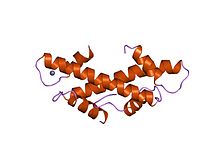TBP-associated factor
| TBP associated factor (TAF6) | |||||||||
|---|---|---|---|---|---|---|---|---|---|
 drosophila dtafii42/dtafii62 (like TAF6/TAF9) heterotetramer, HFD | |||||||||
| Identifiers | |||||||||
| Symbol | TAF | ||||||||
| Pfam | PF02969 | ||||||||
| Pfam clan | CL0012 | ||||||||
| InterPro | IPR004823 | ||||||||
| SCOP2 | 1bh9 / SCOPe / SUPFAM | ||||||||
| |||||||||
The TBP-associated factors (TAF) are proteins that associate with the TATA-binding protein in transcription initiation. It is a part of the transcription initiation factor TFIID multimeric protein complex. It also makes up many other factors, including SL1. They mediate the formation of the transcription preinitiation complex, a step preceding transcription of DNA to RNA by RNA polymerase II.
TAFs have a signature N-terminal histone-like fold domain (HFD).[1] This domain is implicated in the pairwise interaction among specific TAFs.[2]
Function
TFIID
TFIID plays a central role in mediating promoter responses to various activators and repressors. It binds tightly to TAFII-250 and directly interacts with TAFII-40. TFIID is composed of TATA binding protein (TBP) and a number of TBP-associated factors (TAFS).[3]
TAF is part of the TFIID complex, and interacts with the following:
- Specific transcriptional activators
- Basal transcription factors
- Other TAFIIs
- Specific DNA sequences, for example the downstream promoter element or gene-specific core promoter sequence
Due to such interactions, they contribute transcription activation and to promoter selectivity.[3]
Some pairs of TAF interact with each other to form "lobes" in TFIID. Pairs known or suggested to exist in TFIID include TAF6-TAF9, TAF4-TAF12, TAF11-13, TAF8-TAF10 and TAF3-TAF10.[2]
SL1
Selective factor 1 is composed of the TATA-binding protein and three TAF (TATA box-binding protein-associated factor) subunits (TAF1A, TAF1B, and TAF1C). These TAFs do not have a histone-like fold domain.[4]
Other complexes
This section is missing information about subunits of SAGA and related complexes, and pair-forming therein. (April 2019) |
TAF is a part of SAGA (SPT-ADA-GCN5 acetylase) and related coactivation complexes.[2] Such complexes acetylate histone tails to activate genes.[5] Human has three SAGA-like complexes: PCAF, TFTC (TBP-free TAF-containing complex), and STAGA (SPT3-TAF9-GCN5L acetylase). PCAF (GCN5) and KAT2A (GCN5L) are two human homologs of the yeast Gcn5.[6]
TAF8, TAF10, and SPT7L forms a small TAF complex called SMAT.[2]
Structure
The N-terminal domain of TAF has a histone-like protein fold. It contains two short alpha helices and a long central alpha helix.[1]
Human genes
This section is missing information about TAFs in non-TF2D complexes. (April 2019) |
- TAF1 (TAFII250)
- TAF2 (CIF150)
- TAF3 (TAFII140)
- TAF4 (TAFII130/135)
- TAF4B (TAFII105)
- TAF5 (TAFII100)
- TAF6 (TAFII70/80)
- TAF6L (PAF65A)
- TAF7 (TAFII55)
- TAF8 (TAFII43)
- TAF9 (TAFII31/32)
- TAF9B (TAFII31L)
- TAF10 (TAFII30)
- TAF11 (TAFII28)
- TAF12 (TAFII20/15)
- TAF13 (TAFII18)
- TAF15 (TAFII68)
Assorted signatures
TAF domains are spread out across many digital signatures:
References
- ^ a b Xie X, Kokubo T, Cohen SL, Mirza UA, Hoffmann A, Chait BT, Roeder RG, Nakatani Y, Burley SK (March 1996). "Structural similarity between TAFs and the heterotetrameric core of the histone octamer". Nature. 380 (6572): 316–22. Bibcode:1996Natur.380..316X. doi:10.1038/380316a0. PMID 8598927. S2CID 4329570.
- ^ a b c d Demény MA, Soutoglou E, Nagy Z, Scheer E, Jànoshàzi A, Richardot M, Argentini M, Kessler P, Tora L (March 2007). "Identification of a small TAF complex and its role in the assembly of TAF-containing complexes". PLOS ONE. 2 (3): e316. Bibcode:2007PLoSO...2..316D. doi:10.1371/journal.pone.0000316. PMC 1820849. PMID 17375202.
- ^ a b Furukawa T, Tanese N (September 2000). "Assembly of partial TFIID complexes in mammalian cells reveals distinct activities associated with individual TATA box-binding protein-associated factors". The Journal of Biological Chemistry. 275 (38): 29847–56. doi:10.1074/jbc.M002989200. PMID 10896937.
- ^ Friedrich JK, Panov KI, Cabart P, Russell J, Zomerdijk JC (August 2005). "TBP-TAF complex SL1 directs RNA polymerase I pre-initiation complex formation and stabilizes upstream binding factor at the rDNA promoter". The Journal of Biological Chemistry. 280 (33): 29551–8. doi:10.1074/jbc.M501595200. PMC 3858828. PMID 15970593.
- ^ Bonnet J, Wang CY, Baptista T, Vincent SD, Hsiao WC, Stierle M, Kao CF, Tora L, Devys D (September 2014). "The SAGA coactivator complex acts on the whole transcribed genome and is required for RNA polymerase II transcription". Genes & Development. 28 (18): 1999–2012. doi:10.1101/gad.250225.114. PMC 4173158. PMID 25228644.
- ^ Martinez E, Palhan VB, Tjernberg A, Lymar ES, Gamper AM, Kundu TK, Chait BT, Roeder RG (October 2001). "Human STAGA complex is a chromatin-acetylating transcription coactivator that interacts with pre-mRNA splicing and DNA damage-binding factors in vivo". Molecular and Cellular Biology. 21 (20): 6782–95. doi:10.1128/MCB.21.20.6782-6795.2001. PMC 99856. PMID 11564863.